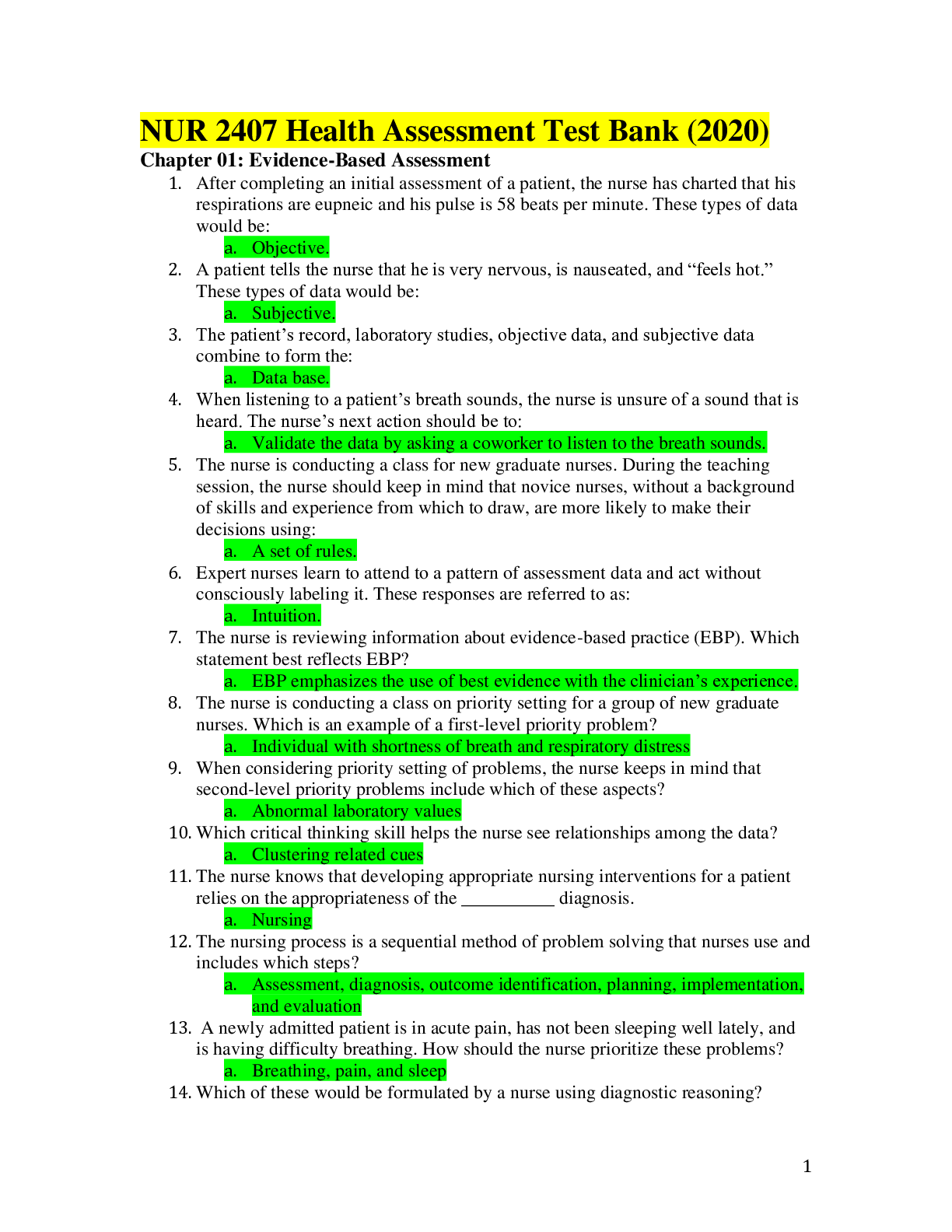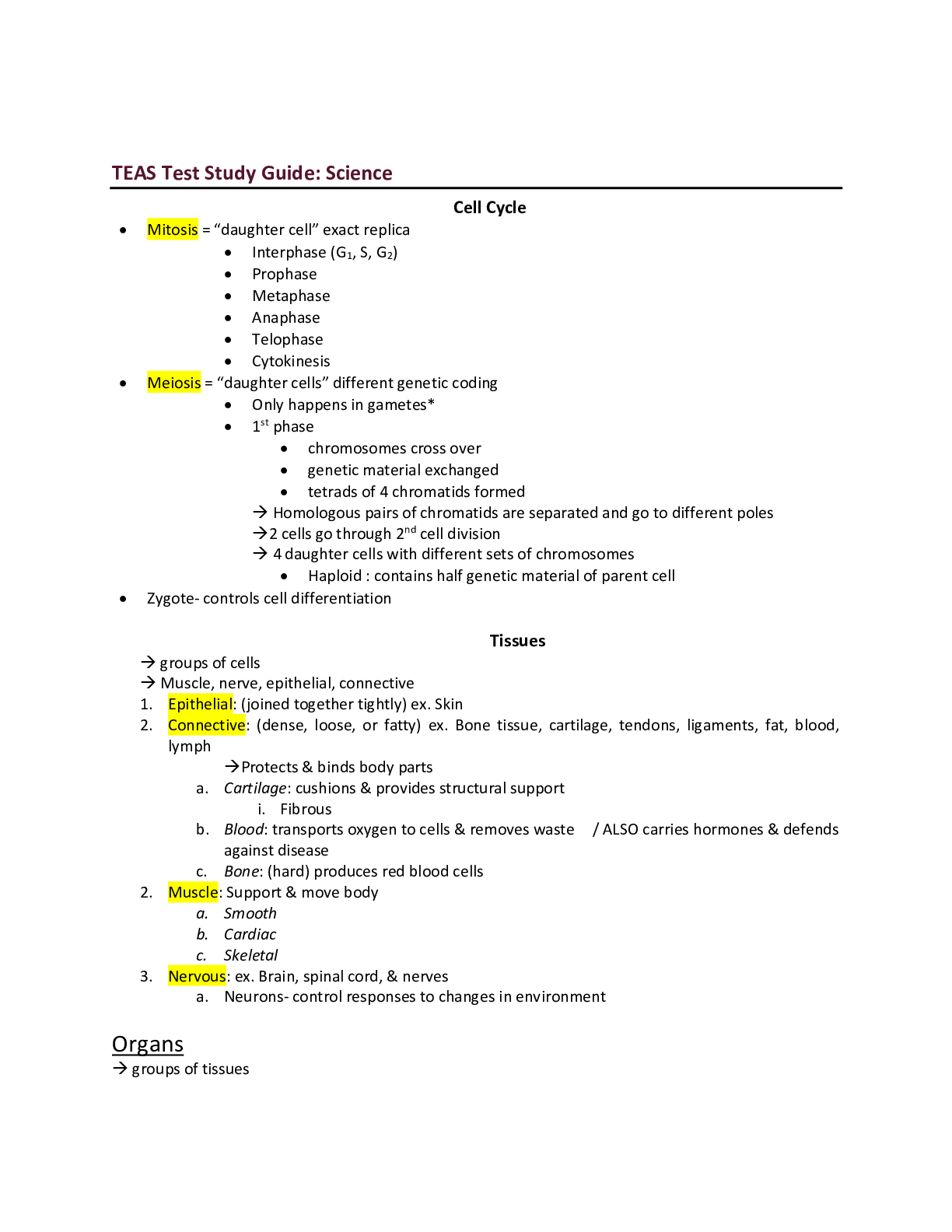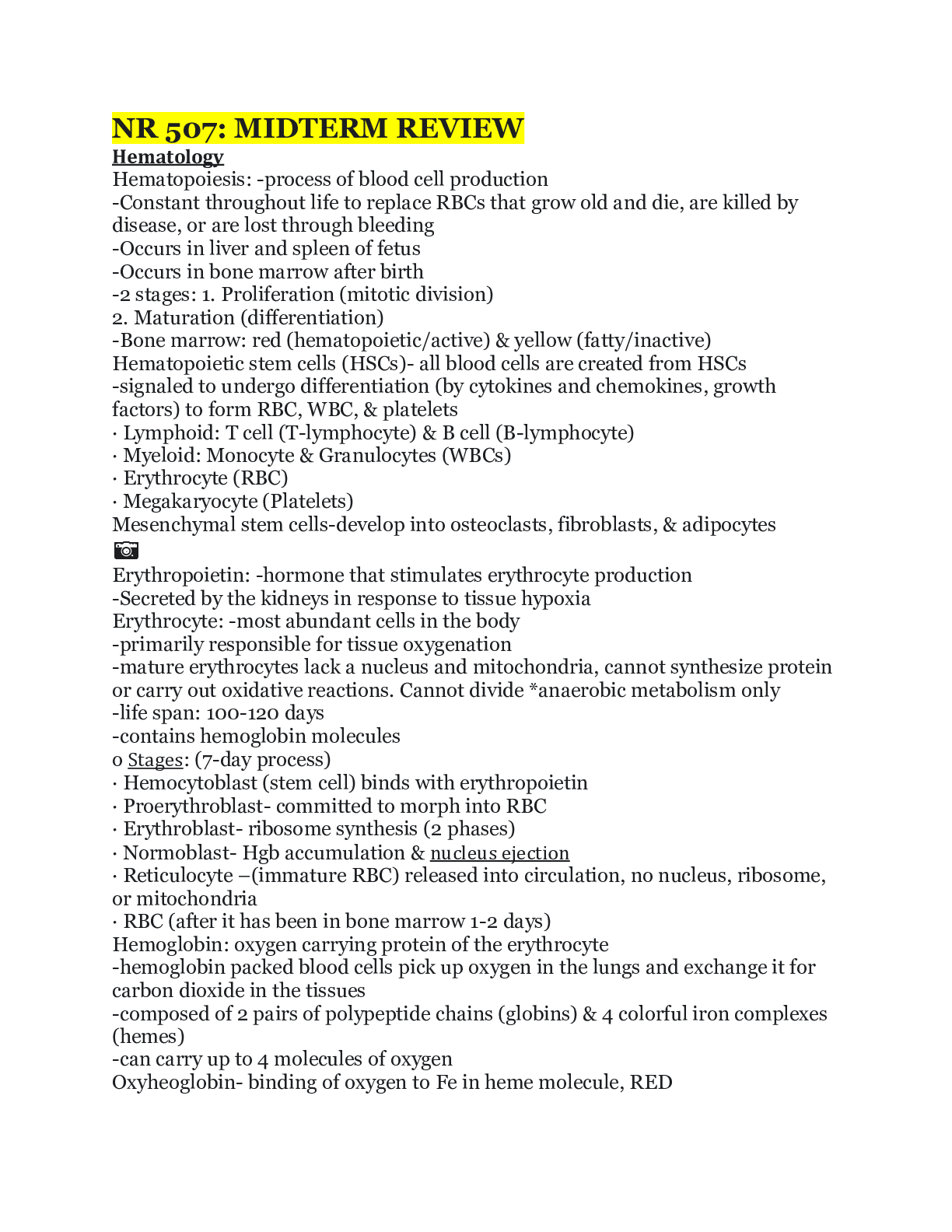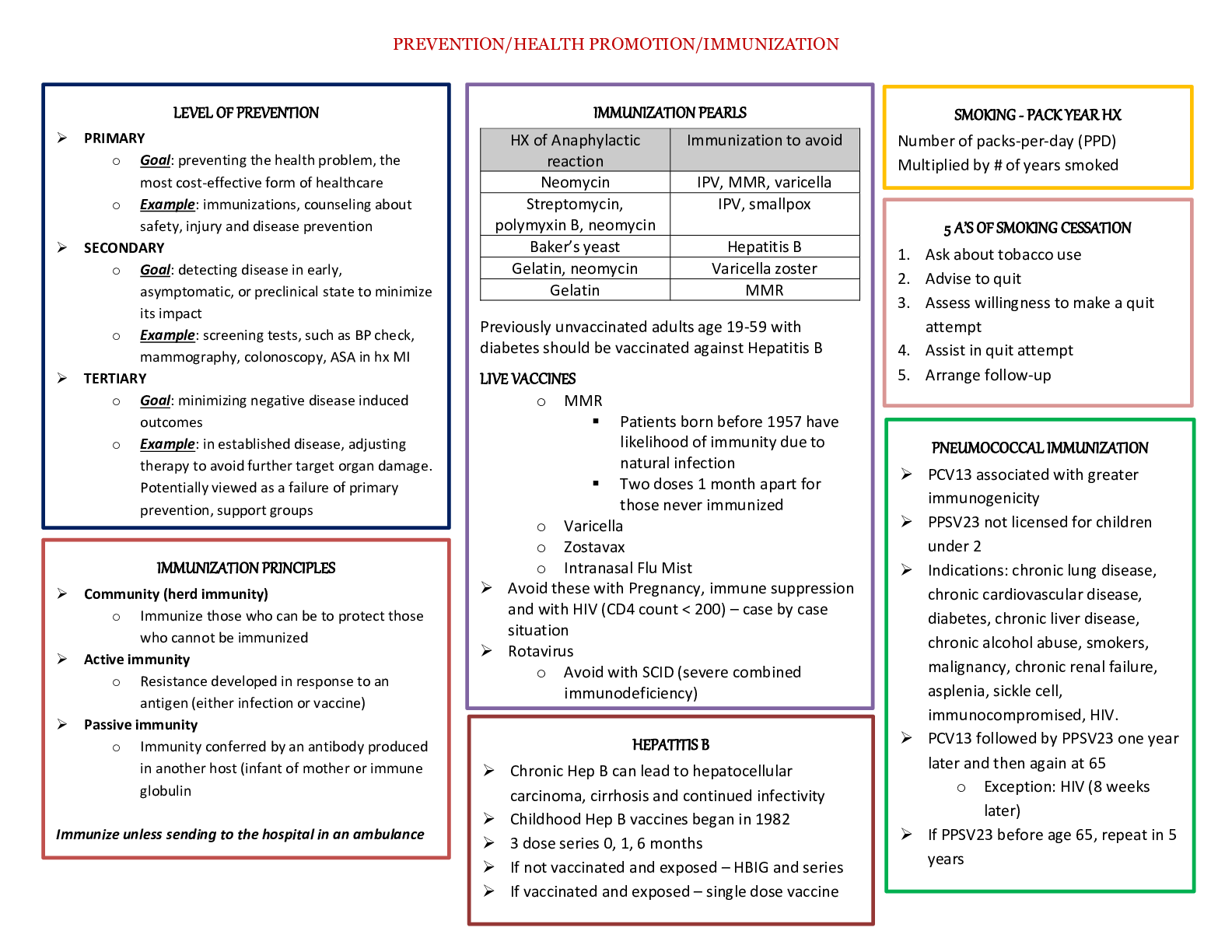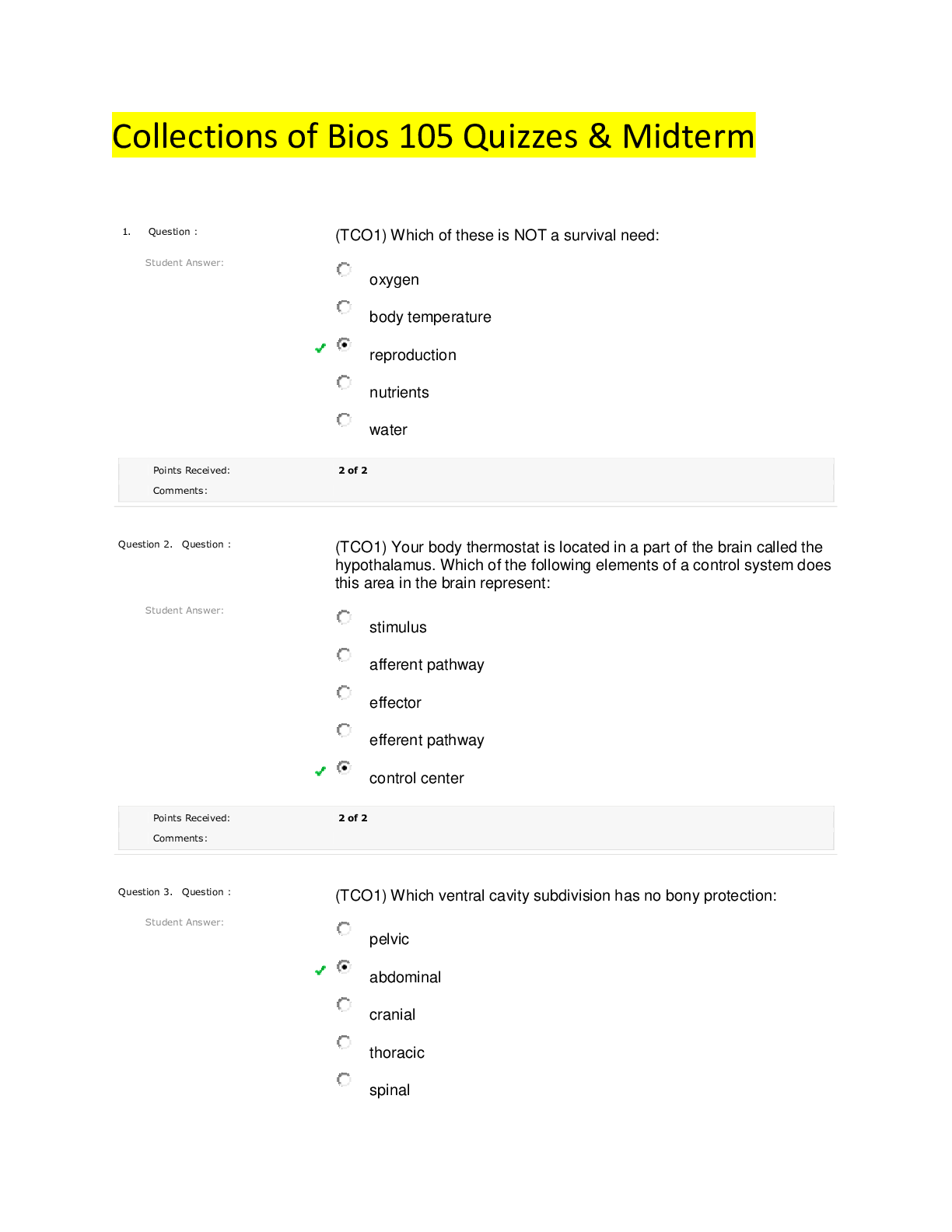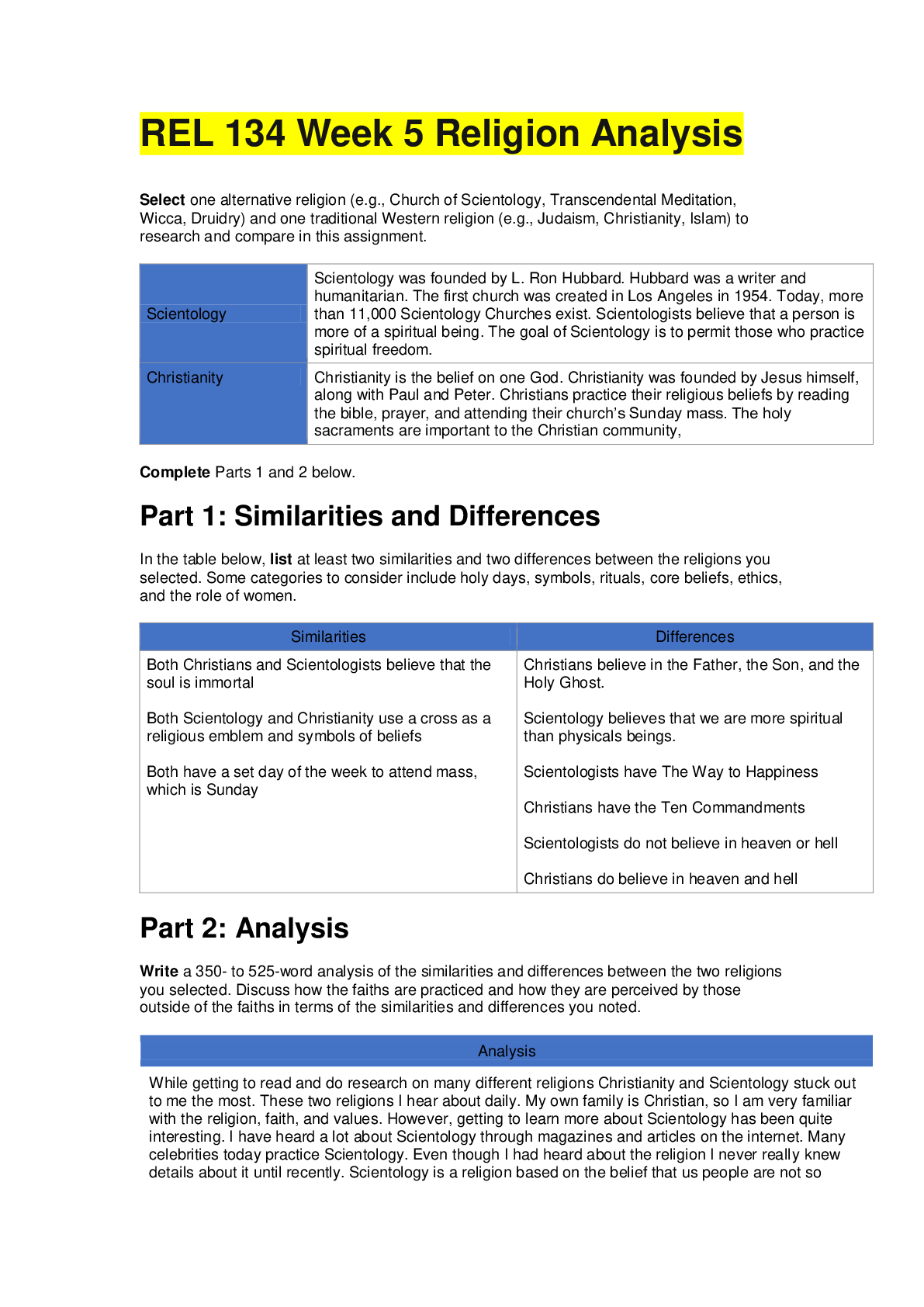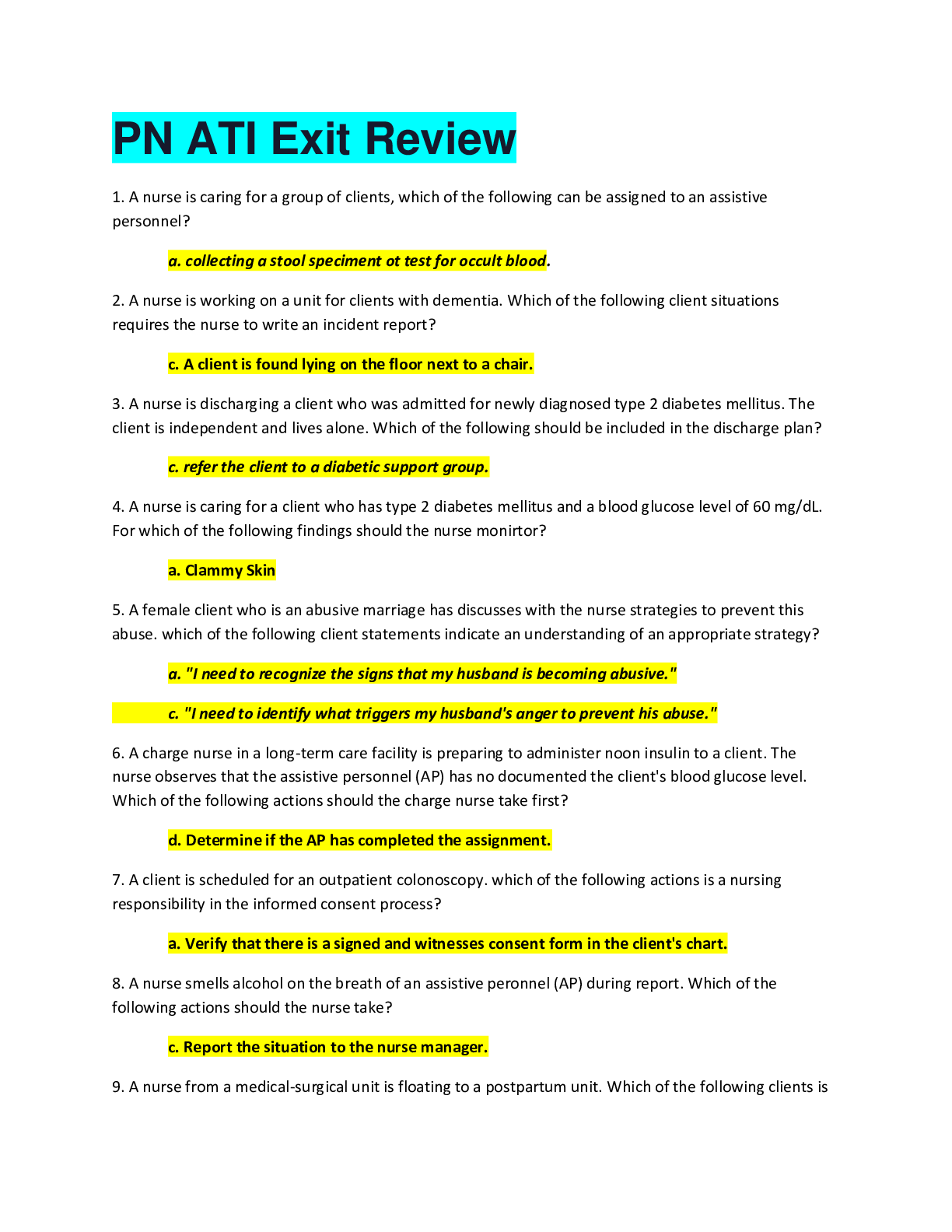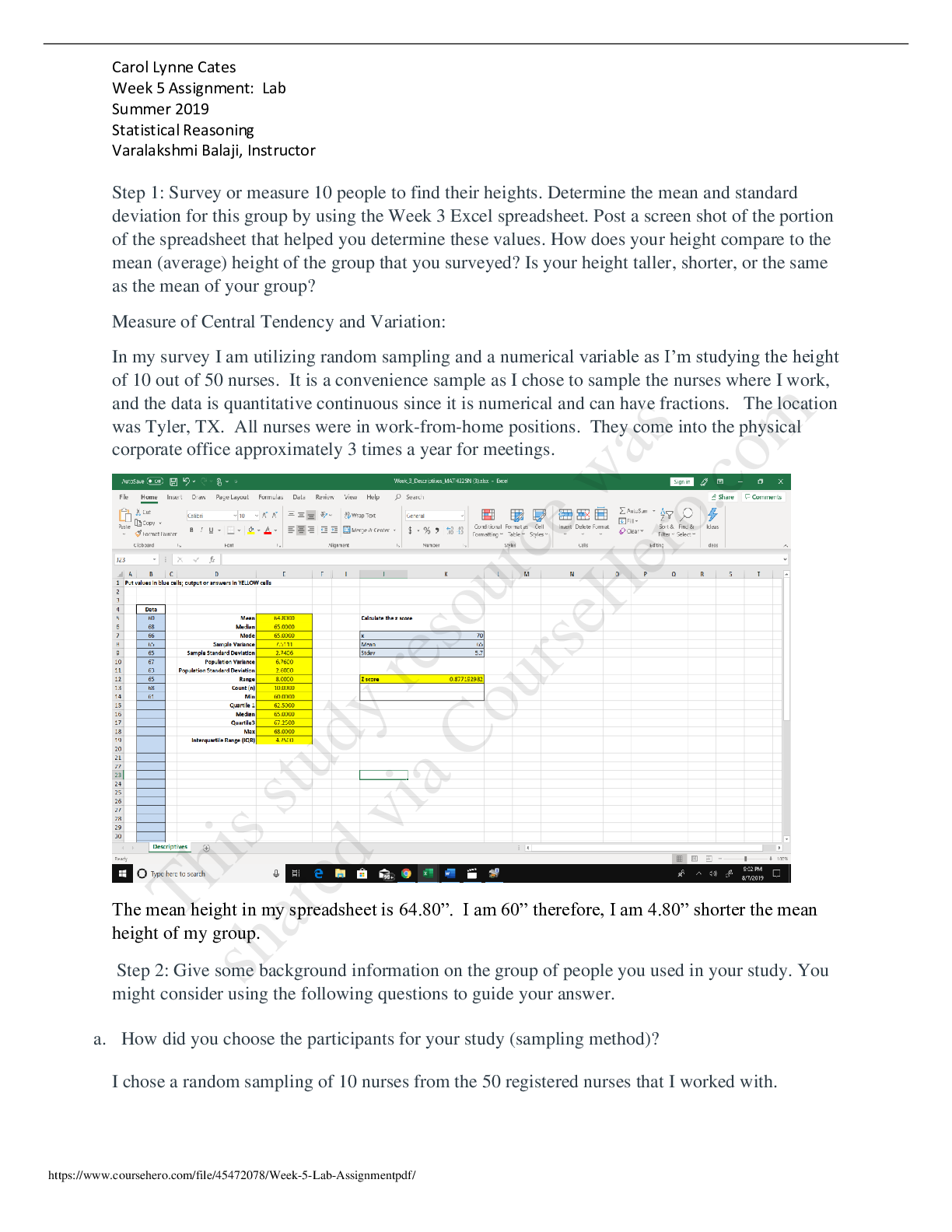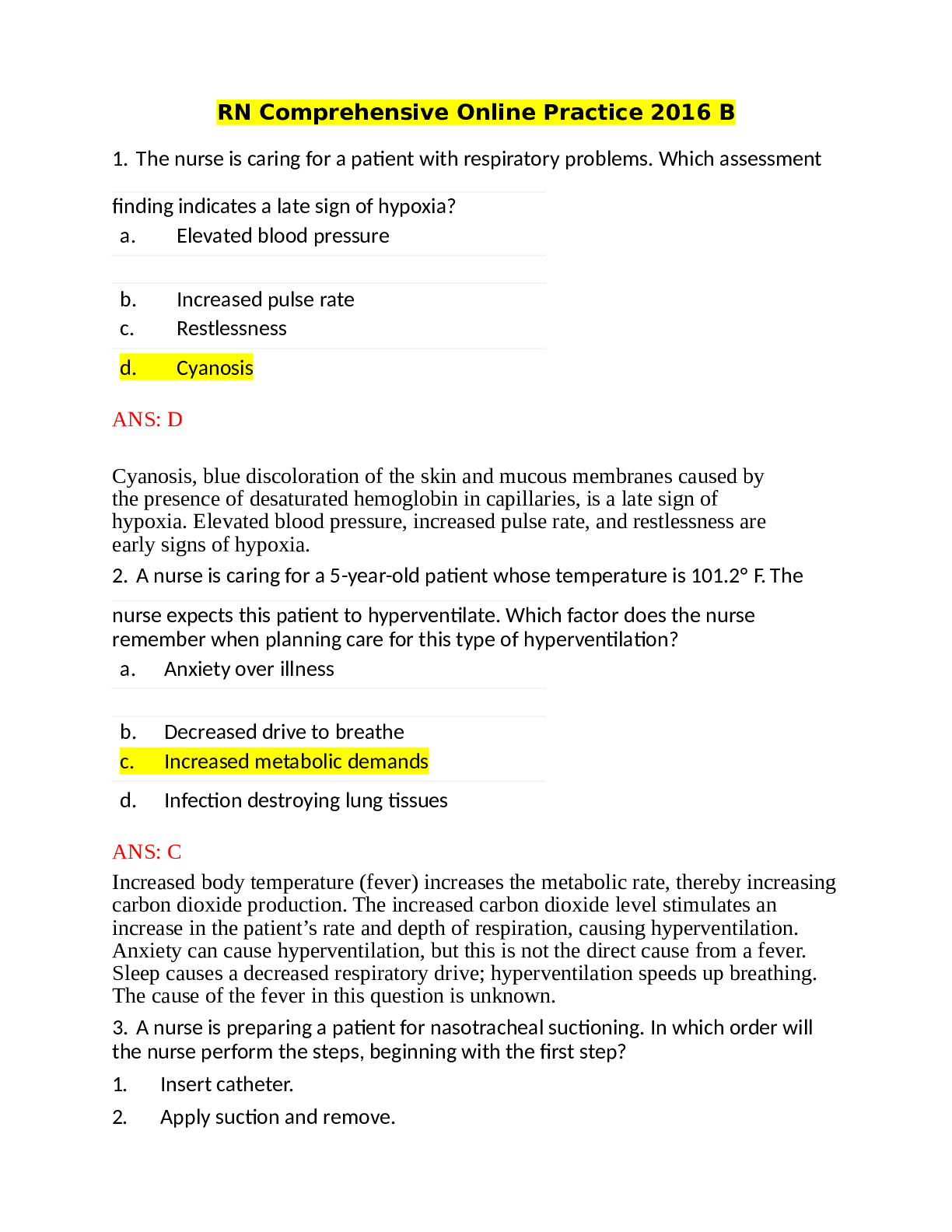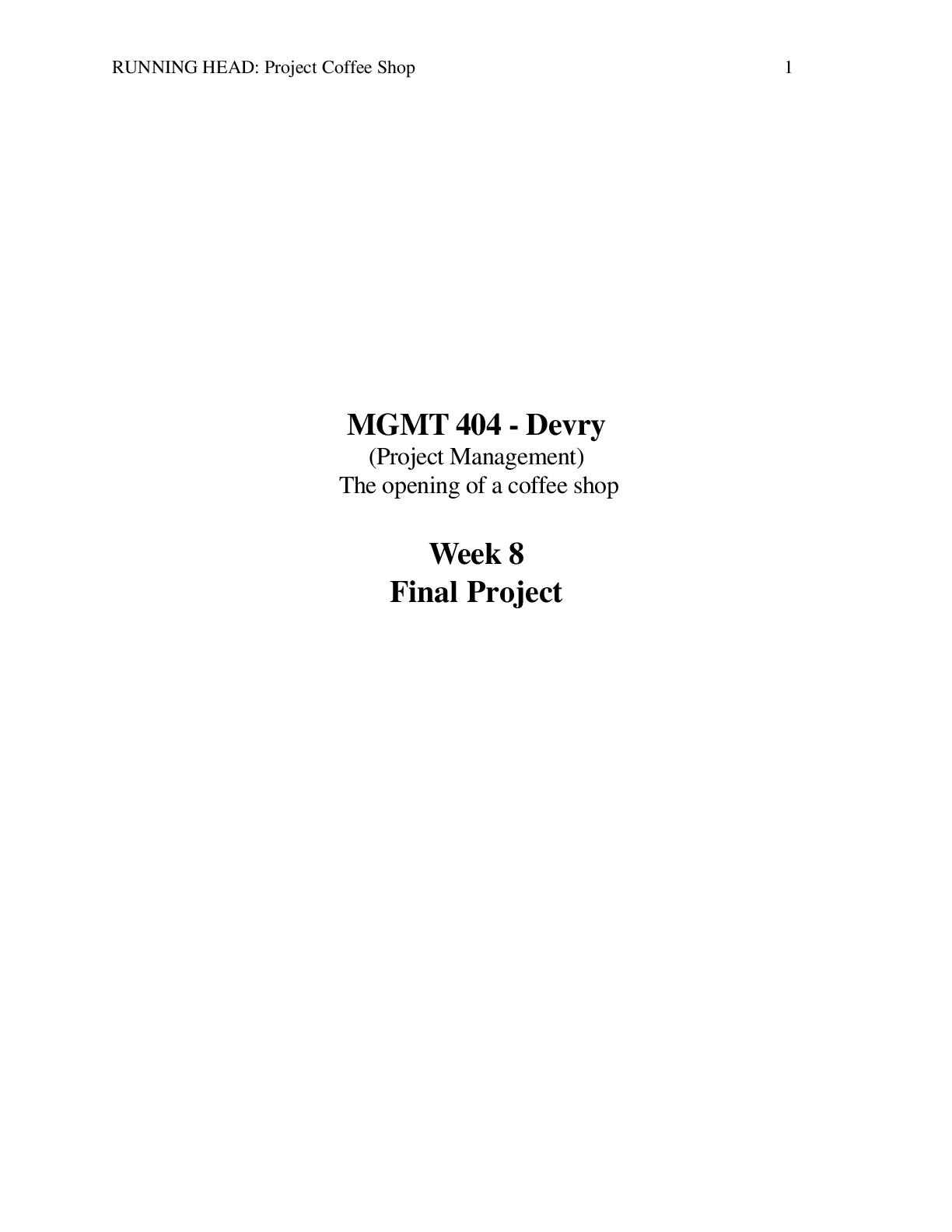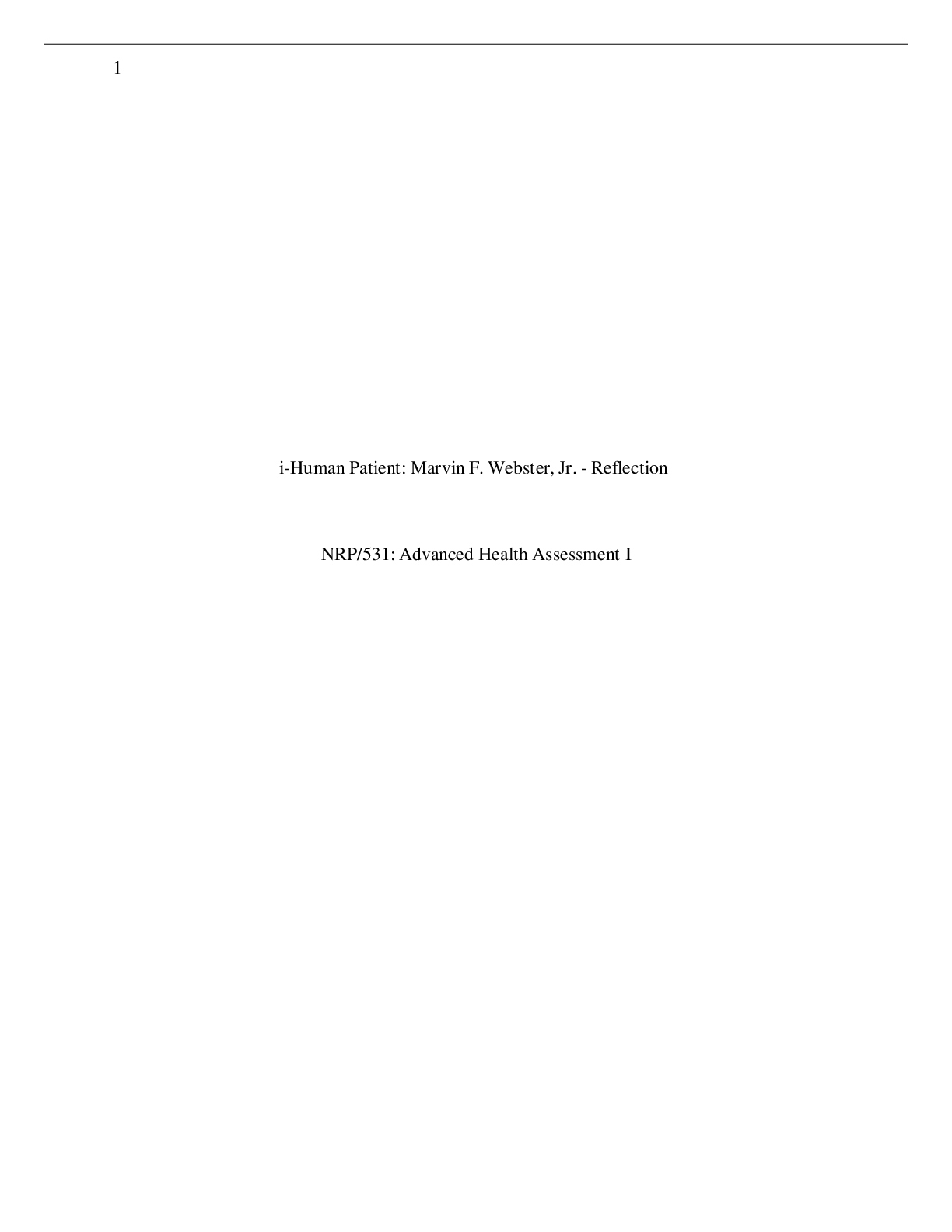*NURSING > STUDY GUIDE > ATI Comprehensive Predictor Study Guide, Complete Solution guide, Latest Summer 2020.A+ Guide (All)
ATI Comprehensive Predictor Study Guide, Complete Solution guide, Latest Summer 2020.A+ Guide
Document Content and Description Below
Comprehensive Predictor Study Guide 1. Professional Responsibilities: Durable Power of Attorney for Health Care A. A durable power of attorney for health care/health care proxy is a lega... l document that designates a health care surrogate, who is an individual authorized to make healthcare decisions for a client who is unable. B. The person who serves in the role of health care surrogate to make decisions for the client should be very familiar with the client’s wishes. C. Living wills can be difficult to interpret, especially in the face of unexpected circumstances. A durable power of attorney for health care, as an adjunct to a living will, can be a more effective way of ensuring that the client’s decisions about health care are honored. 2. Professional Responsibilities: Educating Staff About Client Advocacy A. As advocates, nurses must ensure that clients are informed of their rights and have adequate information on which to base health care decisions. B. Nurses must be careful to assist clients with making health care decisions and not direct or control their decisions. C. Nurses mediate on the client’s behalf when the actions of others are not in the client’s best interest or changes need to be made in the plan of care. D. Do not need a lawyer E. Situations in which nurses might need to advocate o End‑of‑life decisions o Access to health care o Protection of client privacy o Informed consent o Substandard practice NURSING ROLE IN ADVANCE DIRECTIVES A. Providing written information regarding advance directives B. Documenting the client’s advance directives status C. Ensuring that advance directives are current and reflective of the client’s current decisions D. Recognizing that the client’s choice takes priority when there is a conflict between the client and family, or between the client and the provider E. Informing all members of the health care team of the client’s advance directives 3. Professional responsibilities: Client Advocacy 4. Cultural and Spiritual Nursing Care: Working With an Interpreter A. Use only a facility‑approved medical interpreter. Do not use the client’s family or friends, or a nondesignated employee to interpret. B. Inform the interpreter about the reason for and the type of questions that will be asked, the expected response (brief or detailed), and with whom to converse. C. Allow time for the interpreter and the family to be introduced and become acquainted before starting the interview. D. Ask one question at a time E. Direct the questions to the family, not to the interpreter. Use lay terminology F. Do not interrupt the interpreter, the client, or the family as they talk. Following the interview, ask the interpreter for any additional thoughts about the interview and the client’s and family’s responses, both verbal and nonverbal. 5. Overview of Community Health Nursing: Adhering to Ethical Principals A. Respect for autonomy o Allow individuals to select actions to fulfill their goals B. Nonmaleficence o No harm is done when applying standards of care C. Beneficence o Maximize possible benefits and minimize possible harms D. Distributive justice o Fair distribution of the benefits and burden in society is based on the needs and contributions of its members 6. Cultural and spiritual nursing care: Appropriate use of an Interpreter 7. Managing Client Care: Assigning a Task to an Assistive Personnel TO AP A. Activities of daily living (ADLs) B. Bathing C. Grooming D. Dressing E. Toileting F. Ambulating G. Feeding (without swallowing precautions) H. Positioning I. Routine tasks J. Bed making K. Specimen collection L. Intake and output M. Vital signs (for stable clients) N. Postmortem care 8. Managing Client Care: Decision Making About Delegation A. Use nursing judgment and knowledge related to the scope of practice and delegate’s skill level when delegating. B. Use the five rights of delegation o What tasks the nurse delegate (right task) o Under what circumstances (right circumstance) o To whom (right person) o What information should be communicated (right direction/communication) o How to supervise/evaluate (right supervision/evaluation) 9. Managing Client Care: Delegating Tasks to a Licensed Practical Nurse A. Monitoring findings (as input to the RN ’s ongoing assessment) B. Reinforcing client teaching from a standard care plan C. Performing tracheostomy care D. Suctioning E. Checking NG tube patency F. Administering enteral feedings G. Inserting a urinary catheter H. Administering medication (excluding IV medication in some states) I. Don’t delegate what you can EAT- evaluate, assess, teach. No blood, no TPN, or initial assessment 10. Managing Client Care: Delegating Tasks to Assistive Personnel: Considerations for selection: A. Education, training, and experience B. Knowledge and skill to perform the task C. Level of critical thinking required to complete the task D. Ability to communicate with others as it pertains to the task E. Demonstrated competence F. The delegate's culture 11. Managing Client Care: Effective Time Management Time savers A. Documenting nursing interventions as soon as possible after completion to facilitate accurate and thorough documentation B. Grouping activities that are to be performed on the same client or are in close physical proximity to prevent unnecessary walking C. Estimating how long each activity will take and planning accordingly D. Mentally envisioning the procedure to be performed and gathering all equipment prior to entering the client’s room E. Taking time to plan care and taking priorities into consideration F. Delegating activities to other staff when client care workload is beyond what can be handled by one nurse G. Enlisting the aid of other staff when a team approach is more efficient than an individual approach H. Completing more difficult or strenuous tasks when energy level is high I. Avoiding interruptions and graciously but assertively saying “no” to unreasonable or poorly timed requests for help J. Setting a realistic standard for completion of care and level of performance within the constraints of assignment and resources K. Completing one task before beginning another task L. Breaking large tasks into smaller tasks to make them more manageable M. Using an organizational sheet to plan care N. Using breaks to socialize with staff Time wasters A. Documenting at the end of the shift all client care provided and assessments done B. Making repeated trips to the supply room for equipment C. Providing care as opportunity arises regardless of other responsibilities D. Missing equipment when preparing to perform a procedure E. Failing to plan or managing by crisis F. Being reluctant to delegate or under delegating G. Not asking for help when needed or trying to provide all client care independently H. Procrastinating: delaying time‑consuming, less desirable tasks until late in the shift I. Agreeing to help other team members with lower priority tasks when time is already compromised J. Setting unrealistic standards for completion of care and level of performance within constraints of assignment and resources K. Starting several tasks at once and not completing tasks before starting others L. Not addressing low level of skill competency, increasing time on task M. Providing care without a written plan N. Socializing with staff during client care time 12. Managing Client Care: Organizing Workload to Manage Time Effectively TIME MANAGEMENT A. Organize care according to client care needs and priorities. B. What must be done immediately (administration of analgesic or antiemetic, assessment of unstable client)? C. What must be done by a specific time to ensure client safety, quality care, and compliance with facility policies and procedures (routine medication administration, vital signs, blood glucose monitoring)? D. What must be done by the end of the shift (ambulation of the client, discharge and/or discharge teaching, dressing change)? o What can the nurse delegate? o What tasks can only the RN perform? E. What client care responsibilities can the nurse delegate to other health care team members, such as practical nurses (PNs) and assistive personnel (APs)? F. Use time‑saving strategies and avoid time wasters. (1.2) G. Good time management o Facilitates greater productivity. o Decreases work‑related stress. o Helps ensure the provision of quality and appropriately prioritized client care. o Enhances satisfaction with care provided. H. Poor time management I. Impairs productivity. J. Leads to feelings of being overwhelmed and stressed. K. Increases omission of important tasks. L. Creates dissatisfaction with care provided. Time management is a cyclic process. A. Time initially spent developing a plan will save time later and help to avoid management by crisis. B. Set goals and plan care based on established priorities and thoughtful utilization of resources. C. Complete one client care task before beginning the next, starting with the highest priority task. D. Reprioritize remaining tasks based on continual reassessment of client care needs. E. At the end of the day, perform a time analysis and determine if time was used wisely. TIME MANAGEMENT AND SELF‑CARE A. Take time for yourself. B. Schedule time for breaks and meals. C. Take physical and mental breaks from work and the unit. 13. Managing Client Care: Responding to an Incomplete Delegated Task SUPERVISION A. Occurs after delegation. A supervisor oversees a staff member’s performance of delegated activities and determines if: B. Completion of tasks is on schedule. C. Performance was at a satisfactory level. D. Unexpected findings were documented and reported. E. Assistance is needed to complete assigned tasks in a timely manner. Assignment should be reevaluated and possibly changed 14. Managing Client Care: Utilizing the Five Rights of Delegation Right task A. Identify what tasks are appropriate to delegate for each specific client. B. Delegate to appropriate team members (AP, LPN) o RIGHT TASK: Delegate an AP to assist a client who has pneumonia to use a bedpan. o WRONG TASK: Delegate an AP to administer a nebulizer treatment to a client who has pneumonia Right circumstance A. RIGHT CIRCUMSTANCE: Delegate an AP to measure the vital signs of a client who is postoperative and stable. B. WRONG CIRCUMSTANCE: Delegate an AP to measure the vital signs of a client who is postoperative and received naloxone to reverse respiratory depression. Right person A. The task must be within the team member’s scope of practice. B. The team member must have the necessary competence/training. C. Continually review the performance of the team member o RIGHT PERSON: Delegate an PN to administer enteral feedings to a client who has a head injury. o WRONG PERSON: Delegate an AP to administer enteral feedings to a client who has a head injury. Right direction/communication A. Communicate either in writing or orally. B. Data that needs to be collected C. Method and timeline for reporting, including when to report concerns/findings D. Specific task(s) to be performed; client‑specific instructions E. Expected results, timelines, and expectations for follow‑up communication o RIGHT DIRECTION AND COMMUNICATION: Delegate an AP to assist Mr. Martin in room 312 with a shower before 0900. o WRONG DIRECTION AND COMMUNICATION: Delegate an AP to assist Mr. Martin in room 312 with morning hygiene. Right supervision/evaluation A. The delegating nurse must: o Provide supervision, either directly or indirectly (assigning supervision to another licensed nurse). o Provide clear directions and expectations of the task to be performed (time frames, what to report). o Monitor performance. o Provide feedback. o Intervene if necessary (unsafe clinical practice). o Evaluate the client and determine if client outcomes were met. o Evaluate client care tasks and identify needs for quality improvement activities and/or additional resources. § RIGHT SUPERVISION: Delegate the ambulation of a client to an AP. Observe the AP to ensure safe ambulation of the client, and provide positive feedback to the AP after completion of the task. § WRONG SUPERVISION: Delegate the ambulation of a client to an AP without supervision to determine the need for intervention and failing to provide feedback to the AP. 15. Managing Client Care: Providing Cost-Effective Care Cost‑effective A. Strategies that achieve optimal results in relation to the money spent to achieve those results. In other words, cost‑effective means “getting your money’s worth.” o Example: Spending increased money on staff training for transmission‑based precautions resulting in the increased and effective use of PPE for client care. These actions have the result of a decrease in infection transmission and an overall savings in the cost of caring for clients who would have acquired these infections. COST‑EFFECTIVE CARE STRATEGIES A. Providing clients with needed education to decrease or eliminate future medical costs associated with future complications. o Example: Teaching a client who has a new diagnosis of diabetes mellitus how to adjust the dosage of insulin depending on activity level reducing the risk of hypoglycemia resulting in the need for medical care. B. Promoting the use of evidence‑based care resulting in improved client care outcomes. o Example: Implementing the use of evidence‑based techniques to care for clients who have indwelling catheters resulting in a decreased incidence of catheter‑acquired urinary tract infections. C. Promoting cost‑effective resource management. o Example: Using all levels of personnel to their fullest when making assignments. Delegating effectively to members of the nursing care team. o Example: Providing necessary equipment and properly charging clients. o Example: Returning uncontaminated, unused equipment to the appropriate department for credit. o Example: Using equipment properly to prevent wastage. o Example: Providing training to staff unfamiliar with equipment. o Example: Returning equipment (IV pumps) to the proper department (central service, central distribution) as soon as it is no longer needed. This action will prevent further cost to clients. D. Patient should not be compromised quality of care **** 16. Managing Client Care: Delegating to an Assistive Personnel 17. Managing Client Care: Delegating Tasks to an Assistive Personnel 18. Managing Client Care: Delegating a Task to a Float Nurse A. Make sure nurse has the knowledge/skill to complete task B. Negotiate new assignment w/ charge nurse 19. Managing Client Care: Steps of the Delegation Process 20. Managing Client Care: Tasks to delegate to an Assistive Personnel 21. Managing Client Care: Delegating care to an Assistive Personnel 22. Cultural and Spiritual Nursing Care: Working with an Interpreter 23. Infection Control: Caring for a Client Who Has Clostridium Difficile A. Contract precautions B. Wash hands with soap and warm water, don’t use gel C. Clean equipment with bleach D. Water soluble, yellow bag for disposing 24. Care of Specific Populations: Priority Action for Family in Grieving A. Assess risk for suicide B. Stay with family C. Allow to express feeling/ allow time to grief D. Provide extra hard (resources – therapy) E. Assess coping mechanism/social support F. GRIEF COUNSELING 25. Managing Client Care: Strategies for Conflict Resolution CONFLICT RESOLUTION STRATEGIES PROBLEM-SOLVING Actions nurses can take to promote open communication and de‑escalate conflicts A. Use “I” statements, and remember to focus on the problem, not on personal differences. B. Move a conflict that is escalating to a private location or postpone the discussion until a later time to give everyone a chance to regain control of their emotions. NEGOTIATION · Each party agrees to give up something Example · One nurse offers to care for Client A today if the other will care for Client B tomorrow. Strategy: Avoiding/Withdrawing · Both parties know there is a conflict, but they refuse to face it or work toward a resolution. · Can be appropriate for minor conflicts or when one party holds more power than the other party or if the issue can work itself out over time. Strategy: Smoothing · One party attempts to “smooth” another party by trying to satisfy the other party. · Often used to preserve or maintain a peaceful work environment. Strategy: Competing/Coercing = throwing people under the bus · One party pursues a desired solution at the expense of others. · Managers can use this when a quick or unpopular decision must be made. · The party who loses something can experience anger, aggravation, and a desire for retribution. Strategy: Cooperating/ Accommodating · One party sacrifices something, allowing the other party to get what it wants. This is the opposite of competing. · The original problem might not actually be resolved. · Can contribute to future conflict. Strategy: Compromising/Negotiating · Each party gives up something. · To consider this a win/lose‑win/lose solution, both parties must give up something equally important. If one party gives up more than the other, it can become a win‑lose solution. Strategy: Collaborating · Both parties set aside their original individual goals work together to achieve a new common goal. · Requires mutual respect, positive communication, and shared decision‑making between parties. 26. Coordinating Client Care: Information to Include in Change-of-shift Report A. Code status B. Allergies C. Current medications o When the next ones are due o Are they on pain medication? D. Pertinent labs E. Current condition/status of patient F. IV fluids/rate G. Any change in care needed H. Any wounds/dressings I. Previous assessment J. Abnormal findings K. If they are going to surgery or a procedure L. If they need blood sugar checked M. Diet (NPO?) N. Activity level O. Plan of care P. BLOOD LOSS* 27. Gastrointestinal Therapeutic Procedures: Priority Findings Following a Colostomy A. If the stoma appears black or purple in color, this indicates a serious impairment of blood flow and requires immediate interventionà EMERGENCY NURSING ACTIONS · Assess the type and fit of the ostomy appliance. Monitor for leakage (risk to skin integrity). · Assess peristomal skin integrity and appearance of the stoma. The stoma should appear pink and moist. · Evaluate stoma output. Output should be more liquid and more acidic the closer the ostomy is to the proximal small intestine. · Empty the ostomy bag when it is ¼ to ½ f full of drainage. · Assess for fluid and electrolyte imbalances, particularly with a new ileostomy. · Evaluate ability of the client or support person to perform ostomy care. Stomal ischemia/necrosis · Stomal appearance should normally be pink or red and moist. · Signs of stomal ischemia are pale pink or bluish purple color and dry appearance. 28. Medications for depressive disorders: Priority Action for a client who has major depressive disorder A. Assess patient risk of harm to self and others B. Evaluate client’s use of drugs and alcohol C. Assess client history of depression and support system 29. Legal and Ethical Issues: Prioritizing the Delivery of Client Care A. Prioritize systemic before local (“life before limb”). o A client in shock over interventions for a client who has a localized limb injury B. Prioritize actual problems before potential future problems. o Administration of medication to a client experiencing acute pain over ambulation of a client at risk for thrombophlebitis C. Recognize and respond to trends vs. transient findings. o Recognizing a gradual deterioration in a client’s level of consciousness and/or Glasgow Coma Scale score D. Recognize indications of medical emergencies and complications vs. expected findings. o Recognizing indications of increasing intracranial pressure in a client who has a new diagnosis of a stroke vs. the findings expected following a stroke E. Apply clinical knowledge to procedural standards to determine the priority action. o Recognizing that the timing of administration of antidiabetic and antimicrobial medications is more important than administration of some other medications F. Maslow's Hierarchy of needs G. Airway, Breathing Circulation D: disability (neurological deficits, stroke in evolution) E: Exposure (Remove clothing for assessment or resuscitation) 30. Managing Client Care: Coordinating Care Following Report A. Set priorities know whom you can delegate to. B. Use priority setting framework to set priorities in management of client care after report (ABCDE, Maslow’s) 31. Managing Client Care: Prioritizing care 32. Managing Client Care: Prioritizing client care 33. Legal Responsibilities: Nursing Role in Informed Consent A. The nurse’s role in the informed consent process is to witness the client’s signature on the informed consent form and to ensure that the provider has obtained the informed consent responsibly. B. EX. Patient understands PICC line** 34. Information Technology: Appropriate Documentation A. Factual: Subjective and objective data B. Nurses should document subjective data as direct quotes, as the client’s statement. C. Subjective data should be supported by objective data so charting is as descriptive as possible. D. Objective data should be descriptive and should include what the nurse sees, hears, feels, and smells. Document the client’s behavior accurately. Instead of writing “client is agitated,” write “client pacing back and forth in his room, yelling loudly.” ************************************CONTINUED************************************** [Show More]
Last updated: 1 year ago
Preview 1 out of 45 pages
Instant download

Buy this document to get the full access instantly
Instant Download Access after purchase
Add to cartInstant download
Reviews( 0 )
Document information
Connected school, study & course
About the document
Uploaded On
Jul 28, 2020
Number of pages
45
Written in
Additional information
This document has been written for:
Uploaded
Jul 28, 2020
Downloads
0
Views
60



